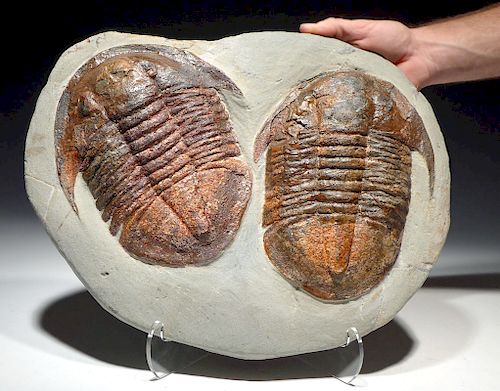Large Ordovician Double Asaphid Trilobite Fossil
Lot 209
About Seller
Artemis Fine Arts
686 S Taylor Ave, Ste 106
Louisville, CO 80027
United States
Selling antiquities, ancient and ethnographic art online since 1993, Artemis Gallery specializes in Classical Antiquities (Egyptian, Greek, Roman, Near Eastern), Asian, Pre-Columbian, African / Tribal / Oceanographic art. Our extensive inventory includes pottery, stone, metal, wood, glass and textil...Read more
Categories
Estimate:
$4,000 - $6,000
Absentee vs Live bid
Two ways to bid:
- Leave a max absentee bid and the platform will bid on your behalf up to your maximum bid during the live auction.
- Bid live during the auction and your bids will be submitted real-time to the auctioneer.
Bid Increments
| Price | Bid Increment |
|---|---|
| $0 | $25 |
| $300 | $50 |
| $1,000 | $100 |
| $2,000 | $250 |
| $5,000 | $500 |
| $10,000 | $1,000 |
| $20,000 | $2,500 |
| $50,000 | $5,000 |
| $100,000 | $10,000 |
| $200,000 | $20,000 |
About Auction
By Artemis Fine Arts
Jun 21, 2018
Set Reminder
2018-06-21 10:00:00
2018-06-21 10:00:00
America/New_York
Bidsquare
Bidsquare : DAY 2 | Pre-Columbian, Ethnographic, Fossils
https://www.bidsquare.com/auctions/artemis-gallery/day-2-pre-columbian-ethnographic-fossils-3277
Day 2 of an important 2-day auction featuring exceptional ethnographic art from around the world Artemis Fine Arts info@artemisgallery.com
Day 2 of an important 2-day auction featuring exceptional ethnographic art from around the world Artemis Fine Arts info@artemisgallery.com
- Lot Description
North Africa, Anti-Atlas Mountains - Morocco, Ordovician period, ca. 485 to 443 million years ago. A natural double specimen of trilobite fossils. The size and beautiful color variances are truly mesmerizing. The color is an inviting mix of salmon reds and pinks mixed with splashes of crimson red, gold and brown. Asaphus is a genus of trilobites, that is known from the Lower and Middle Ordovician Period. Trilobites are a fossil group of extinct marine arthropods that form one of the earliest known groups of arthropods. The first appearance of trilobites in the fossil record defines the base of the Atdabanian stage of the Early Cambrian period (521 million years ago), and they flourished throughout the lower Paleozoic era before beginning a drawn-out decline to extinction when, during the Devonian, all trilobite orders except the Proetids died out. Trilobites disappeared in the mass extinction at the end of the Permian about 252 million years ago. Trilobites were among the most successful of all early animals, roaming the oceans for over 270 million years. Size: 16.25" W x 12.5" H (41.3 cm x 31.8 cm)
By the time trilobites first appeared in the fossil record, they were already highly diversified and geographically dispersed. Because trilobites had wide diversity and an easily fossilized exoskeleton, they left an extensive fossil record, with some 17,000 known species spanning Paleozoic time. The study of these fossils has facilitated important contributions to biostratigraphy, paleontology, evolutionary biology, and plate tectonics.
Provenance: acquired in 2008 from a French collector
All items legal to buy/sell under U.S. Statute covering cultural patrimony Code 2600, CHAPTER 14, and are guaranteed to be as described or your money back.
A Certificate of Authenticity will accompany all winning bids.
We ship worldwide and handle all shipping in-house for your convenience.
#136202Minor repair and crack filling only to outer edge of rock plate. No fabrication.Condition
- Shipping Info
-
All shipping is handled in-house for your convenience. Your invoice from Artemis Gallery will include shipping calculation instructions. If in doubt, please inquire BEFORE bidding for estimated shipping costs for individual items.
-
- Buyer's Premium



 EUR
EUR CAD
CAD AUD
AUD GBP
GBP MXN
MXN HKD
HKD CNY
CNY MYR
MYR SEK
SEK SGD
SGD CHF
CHF THB
THB















